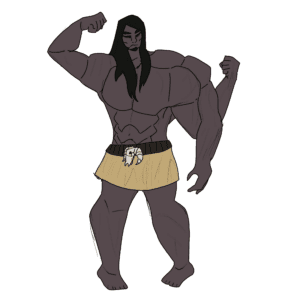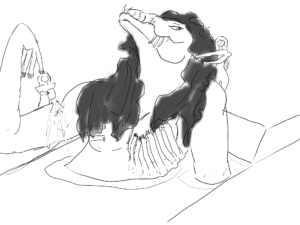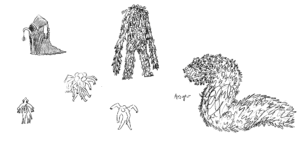Life is hard in the Ashen Wastes. Water and food are scarce. For the longest time, the sands were home to only nomads, specifically a desert-adapted subspecies of Thyr known as the Kuni.
They resemble tall, lithe humanoids with dark gray skin. They have black hair and are highly muscular. They are also resilient; a kuni can naturally go for weeks without water, if they don’t exert themselves in that time, and can live up to a month without a meal. However, in present times, most have taken a more durable albeit unnatural appearance.
Scholars speculate other races may have coexisted with them in the past. Nevertheless, many of these nomadic tribes were eventually united. United by the discovery of a god machine that changed the various desert societies forever…literally.
The unification occurred after a small band of kuni ventured deep into a canyon in the center of the desert. There, in the tunnels below, they found the Godgrafter; a piece of lost technology capable of fusing beings together into crude amalgamations of limbs and flesh. The chieftain of the tribe unsuccessfully attempted to graft a few kuni together, but those attempts were met with their agonizing death. The Godgrafter’s “spirit” informed them that a sacrifice of a thousand bodies would unlock the secret of grafting, and so the chieftain lured several of the largest tribes into the tunnels below the canyon and triggered a cave-in near the entrance. Minutes later, a chorus of screams erupted and then were swiftly silenced. And a god dug itself free of the rubble.
Thus began the Grafters.
Society and Culture
Modern kuni are usually made up of several bodies, or at least one body with extra limbs. These horrors of the flesh are created using fleshgrafting, a technique taught to the Grafters by their first god. If a Grafter finds a body, it is usually that of their fallen foe, they can graft it onto themselves. At times, they may even gain the knowledge of the previous individual.
If a Grafter is in the desert without food, they can absorb these extra bodies for energy and nutrients. And if they have enough bodies, limbs can be considered expendable, allowing feats of strength to be achieved that would normally render an individual severely injured from the forces involved. The largest, oldest among them can be made up of hundreds of bodies. Only a few have ever achieved this, and those who have are considered living gods.
To become a god, a Grafter with enough bodies will go to the Godgrafter and have it ‘smooth out’ the bodies into one. Turning a twisted, ununified amalgamation into something ‘beautiful’. And these gods are indeed beautiful, often renowned as elegant or sensual beasts.
As of yet, three gods exist, with another expected in the next few years.
The first and oldest of the gods is Sobek. She usually stands at about 35 feet tall and has a face resembling the head of a crocodile. Her long jaws bare teeth crafted from ribs and femurs. She’s known as the first and greatest fleshgrafter, and lives a life of luxury, served by her devoted worshippers. A flesh-sacrifice is given to her daily. Despite her rather ‘human’ behavior, she regards mortals as merely parts of a larger potential plan of hers, and thus doesn’t value their lives as individuals. While considered a fertility and childbirth goddess, she doesn’t care as much about offspring or sexual pleasure as many think, spending more of her time relaxing.

Gurogorne, the Crab, has a far less humanoid body. The unification of her various bodies was not so thorough, and her body plan is far more similar to a crab than a human. Her various legs bear a coating of arms that can be used as manipulatory organs, and her central segment is lined by a ring of heads. Despite this grotesque form, her bodies aren’t as lackluster as a typical Grafter, with symmetry and an artistic touch. Gurogorne delights in warfare and bloodshed, getting bored and sometimes depressed if she spends too long in the comfort of civilized life.
Neith is a tall and elegant god. He has a semi-humanoid form, with artistic flourishes formed from limbs and body parts arranged in patterns across his body. He’s the only god to have perfected fleshgrafting animals (beastgrafting) and has numerous beasts built into his body. He wears the skull of some large cetacean or similar aquatic creature over his face as a mask. Neith’s goal in life is the pursuit of knowledge and the perfection of self.
Finally, we reach Arogast. While not yet a god, Arogast is approaching the necessary numbers, with an amorphous form built from about two hundred bodies. They prefer a formless shape to attempting any sort of humanoid bodyplan, and it seems to be working. They’re the strongest of the mortal Grafters and the highest ranking. It’s unclear whether the gods will try to kill them before they’re unified.
While bloodlines are important to the Grafters, there are classifications based on size as well. The majority of Grafters have about one to three bodies, but those who can coordinate their bodies properly can usually attain more. Goliaths have about a dozen bodies and are respected among the Grafters as highly-achieved individuals. Behemoths, at twenty to thirty bodies, often fill the roles of military generals or master craftsmen. Colossi are Grafters who have managed to attain forty to a hundred bodies, and are true forces to be reckoned with; respected as leaders and masters of war. Leviathans have a few hundred bodies and are expected to become gods. Arogast is currently the only leviathan.

While colossi and behemoths usually act as the government, the true rulers are the gods. Their orders are never questioned, whether by merit of their wisdom or by fear. This government isn’t very well organized, acting as a sort of large-scale tribal council. It has some feudal aspects, albeit not very efficiently. Various behemoths and goliaths will be in charge of different groups, often able to lead and declare military conflicts on their own accord. A few colossi are also considered to rule certain large territories, often with lesser rulers below them to divide up the land.
Grafter culture places great value on carnal emotions, such as lust and anger. Philosophy and glory are also respected, and great craftsmen, warriors, and wise-men are revered. If you’re a Grafter and are faced with a chance for glory, you’re expected to take it, and those who prefer an uneventful life are considered probable failures. Achieving a great number of bodies is considered the greatest kind of glory, as it leads to physical power and perhaps even godhood. However, there are some taboos involving the obtainment of such bodies. Using rotting corpses or bodies that have passed away by disease is frowned upon, and living or fresh bodies are preferred. Those who are made up of rotting bodies, while they do exist, are considered plague-bearers and filthy, and as such are outcasts from society. Using the bodies of one’s family is also somewhat taboo. It’s generally best to use the corpses of those slain in battle, such as your enemies or fallen allies.
In battle, Grafters will often use more than physical power alone. Weapons can be wielded to great effect, and generally, the more coordinated a Grafter is with their bodies, the more bodies they can attain. If someone can effectively use four arms, they could dual-wield longbows or two greatswords. Or perhaps a shield and bow, or greatsword and bow. A two-handed axe and a shield could also be handled to great effect or a giant shield held by multiple hands. While usually not innovators, Grafters will perfect what they have, and their weapons are not only of fine craftsmanship but also can be used to dangerous effect.
The Grafter capital is a large fortress built around the canyon the Godcrafter is hidden beneath. The tall walls provide protection from sandstorms and give shade to parts of the city at times. They also keep the city at a more constant temperature, with nights not reaching as cold as the open desert. The city itself is a mess of barracks, bathhouses, and shops, with several keeps for the gods. There are also some aqueducts and canals leading inside, connected to an irrigation network for farmland surrounding the fortress. Tributes to the gods are carried or carted into the city, allowing a higher population than surrounding regions, and a more comfortable life for the immortals. The architecture has a rather spiky design, with a lot of buildings using bamboo-like woody grasses that grow in some parts of the desert. Stone is also a common building material, often featuring organic carvings and patterns. Parts of the canyon have been mined, with numerous buildings and pathways carved into the rock. Some giant worms also live down there, which are gathered as food. Other large settlements exist throughout the Ashen Wastes, but none are as large or important as this central fortress.
Grafter clothing is kept to a minimum. Sobek herself has ‘clothing’ made from her own arms, although even that is scant. Gurogorne never wears anything, despite having plenty of ‘anatomical features’. Neith, however, usually wears a vast cloak of white fabric.
Warriors will often fight naked. Some nomadic Grafters have adopted a wide, flat hat used as a shade, and thin white fabrics are sometimes used to deflect sunlight and cool off. Large backpacks are also common. Disciples of Neith will often wear thin white robes that reach the ground, often featuring long decorative sleeves, to show their detachment from the crudeness of worldly things. If you see a robed Grafter in battle, they may be particularly skilled in magic, such as offensive grafting. A large Grafter, such as most tribute-collectors, might carry a large ‘backpack’ or cart on their back to bring surpluses between cities. These carts can also carry supplies in a battle situation. Warriors might have large belts that carry their weapons and quivers, or supplies like food. Jewelry isn’t uncommon, with piercings decorating the bodies of most wealthy Grafters. Bones, feathers, and gold are commonly used materials in such jewelry.
Although Grafter merchants aren’t common outside the Ashen Wastes, you can sometimes find them selling weapons or trinkets of fine quality. One famous merchant, a former student of Neith, uses beastgrafting to store fresh animals on their body. They’re also known to sell human meat, should a customer want to try it.
Cuisine
Grafter cuisine involves a wide range of foods. Among higher society, meals should be flavorful above all else. Sharp sweet and sour flavors are common. Amongst the lower class or desert nomads, food is whatever can be gathered. Roasted animals are common, along with whatever else can be scoured from the desert. Amongst warriors, a good hearty meal is preferred. Moist food is preferable in the dry desert, but dried meats can be preserved for long periods of time. Things like vinegar, alcohol, sugar, and salt are loved in most dishes.
Grafter meals in the desert involve a lot of roasted meat and wet desert plants. Buried tubers are a good source of water in the desert, often shredded to be drank. When in desperate need of nutrients, a Grafter can absorb their own body, although this is inefficient at best and shouldn’t be attempted when only their natural body is left. Physically eating grafter or other races’ flesh is also an option, and cannibalism is not a cultural taboo, although eating family members is usually discouraged. Bodies are frequently consumed, whether due to desperation or a display of high class. The upper class will often have a diet involving ‘human’ flesh, along with breads, a rice-equivalent, and other meats. Meat is often eaten raw when it is safe to do so, and there’s a famous Grafter dish which is essentially a highly sweet sushi wrapped in meat. It’s often drizzled with sweet or sour syrup and filled with rice-like grains and thin, edible reeds, held together with honey or dense syrup. This food is called Suyon, and a well-made Suyon is marked by a slightly chewy consistency that doesn’t break apart when bitten into. An alternative recipe, considered lower-class, is a lot chewier, with thicker, caramelized syrup and sometimes wrapped in cooked meat. There’s a story that Sobek once had a giant version of Suyon produced for herself, that she hated because the texture was wrong at such sizes and because she can’t chew.
This entry was made by Netherportal11